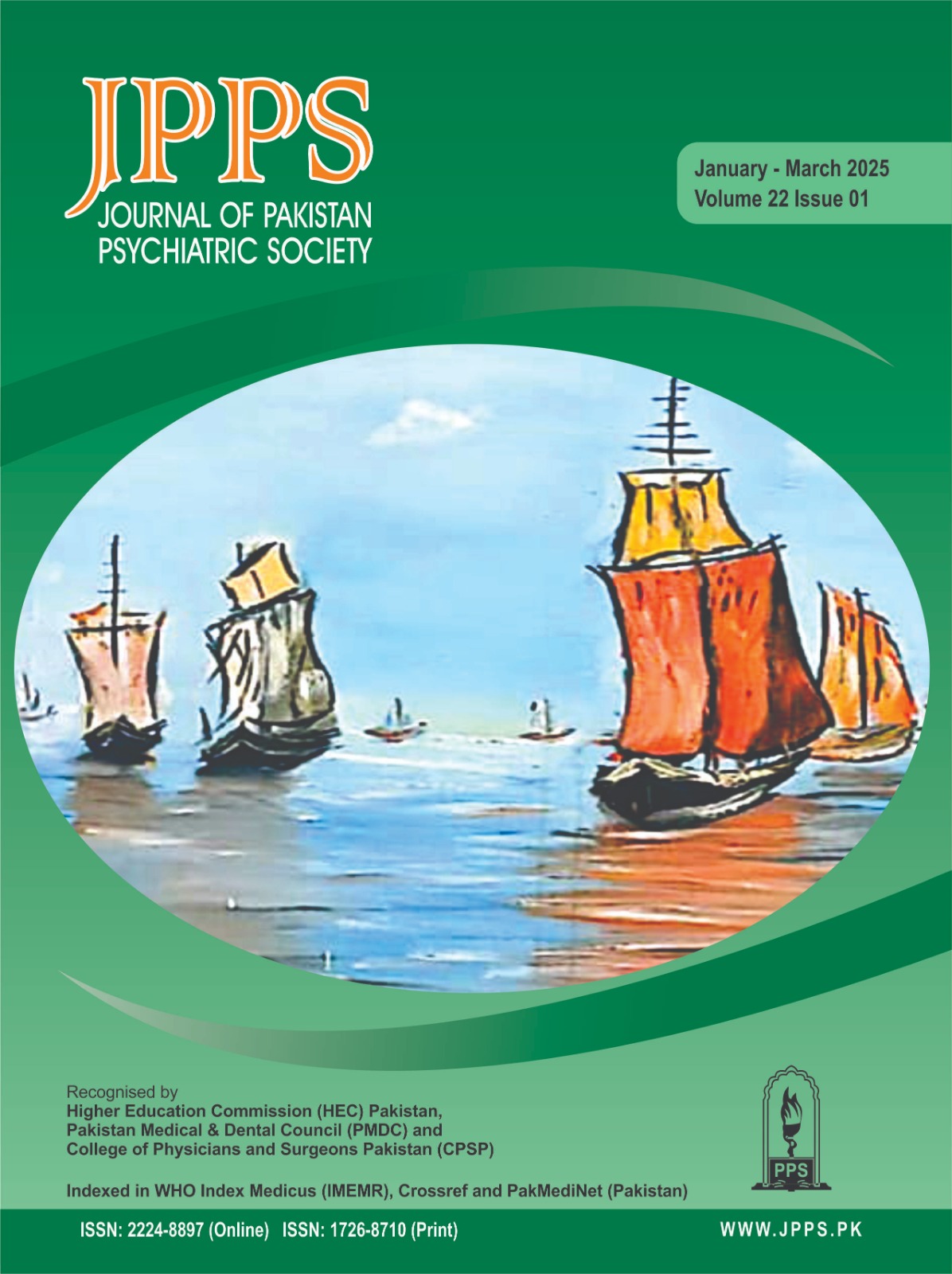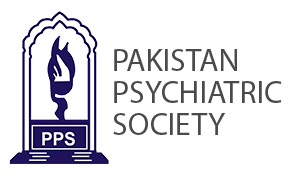EXPLORATION OF INTERNALISED STIGMA AND EMOTIONAL DISTRESS AMONG INDIVIDUALS WITH PSYCHIATRIC ILLNESSES
Abstract
OBJECTIVES
To explore the level of internalized stigma and emotional distress in people with different psychiatric disorders including anxiety disorders, mood disorders, and obsessive compulsive disorders.
STUDY DESIGN
Cross-sectional comparative study
PLACE AND DURATION OF STUDY
Department of Psychiatry at the Services Hospital, Lahore, Pakistan from 1st June 2021 to August 2022 (period of one year).
METHOD
A total of 180 participants which comprised 60 with each psychiatric condition (anxiety disorders, mood disorders, and obsessive compulsive disorders) were recruited from psychiatric department (Ward/OPD) using Purposive and convenience quota sampling technique. Internalized stigma was measured using the Internalized Stigma of Mental Illness Inventory (ISMI) Scale, while emotional distress was examined using the Perceived Emotional Distress Inventory (PEDI).
RESULTS
Variations of stigma in different psychiatric populations experiencing mood disorders, anxiety disorders and OCD were observed. It was found that the higher the experience of internalized stigma, higher the levels of emotional distress.
CONCLUSION
The research observed the variations in impact of internalized stigma among individuals with mood disorders, anxiety disorders, and OCD. It was also found that the higher the experience of internalised stigma, the higher were the levels of emotional distress.
Downloads
References
Aromaa E. Attitudes towards people with mental disorders in a general population in Finland [Internet] [dissertation]. [Vaasa, Finland]: National Institute for Health and Welfare, Mental Health and Substance Abuse Services, Vaasa, Finland; 2011. p. 1–118. Available from: https://jyx.jyu.fi/bitstreams/cab8b3fb-0028-47e1-b462-2dabe10970f0/download
Boyd JE, Adler EP, Otilingam PG, Peters T. Internalized Stigma of Mental Illness (ISMI) scale: a multinational review. Compr Psychiatry. 2014;55(1):221-231. doi: 10.1016/j.comppsych.2013.06.005
Murray L, Cooper P. Effects of postnatal depression on infant development. Arch Dis Child. 1997;77(2):99-101. doi: 10.1136/adc.77.2.99
Khan N, Kausar R, Khalid A, Farooq A. Gender differences among discrimination & stigma experienced by depressive patients in Pakistan. Pak J Med Sci. 2015;31(6):1432-1436. doi: 10.12669/pjms.316.8454
Dovidi JF, Gaertner SL. Aversive Racism. In: Zanna MP, editor. Advances in Experimental Social Psychology Volume 36. San Diego, CA: Elsevier Academic Press; 2004. p. 1–52.
Alonso J, Buron A, Rojas-Farreras S, et al. Perceived stigma among individuals with common mental disorders. J Affect Disord. 2009;118(1-3):180-186. doi: 10.1016/j.jad.2009.02.006
Jasko, A. The Scarlet Letter of Mental Illness: De-stigmatizing Bipolar Disorder. Pastoral Psychology. 2012; 61(3):299–304. doi: https://doi.org/10.1007/s11089-012-0436-1
Shrivastava A, Johnston M, Bureau Y. Stigma of Mental Illness-2: Non-compliance and Intervention. Mens Sana Monogr. 2012;10(1):85-97. doi: 10.4103/0973-1229.90276
Watson AC, Corrigan P, Larson JE, Sells M. Self-stigma in people with mental illness. Schizophr Bull. 2007;33(6):1312-1318. doi: 10.1093/schbul/sbl076
Rüsch N, Corrigan PW, Todd AR, Bodenhausen GV. Implicit self-stigma in people with mental illness. J Nerv Ment Dis. 2010;198(2):150-153. doi: 10.1097/NMD.0b013e3181cc43b5
Livingston JD, Boyd JE. Correlates and consequences of internalized stigma for people living with mental illness: a systematic review and meta-analysis. Soc Sci Med. 2010;71(12):2150-2161. doi: 10.1016/j.socscimed.2010.09.030
Rauf U, Ali U. Prevalence of Internalized Stigma in Persons with Severe Mental Illness in Karachi, Pakistan. J Pak Psychiatr Soc. 2016;13(1):30-33. Available from: https://www.jpps.pk/index.php/journal/article/view/462
Moscoso MS, Lengacher CA, Reheiser EC. The assessment of the perceived emotional distress: The neglected side of cancer care. Psicooncologia. 2012;9(2-3):277-288. doi: 10.5209/rev_PSIC.2013.v9.n2-3.40897
Damani S. Mental Illness in Pakistan: A Subject of Stigma, Ridicule, and Cultural Insensitivity. Journal of Pakistan Medical Association. 2018; 22(1), 11-13.
Brohan E, Elgie R, Sartorius N, Thornicroft G; GAMIAN-Europe Study Group. Self-stigma, empowerment and perceived discrimination among people with schizophrenia in 14 European countries: the GAMIAN-Europe study. Schizophr Res. 2010;122(1-3):232-238. doi: 10.1016/j.schres.2010.02.1065
Ocisková M, Praško J, Kamarádová D, et al. Self-stigma in psychiatric patients -standardization of the ISMI scale. Neuro Endocrinol Lett. 2014;35(7):624-632.
Coles ME, Heimberg RG, Weiss BD. The public's knowledge and beliefs about obsessive compulsive disorder. Depress Anxiety. 2013;30(8):778-785. doi: 10.1002/da.22080
Pena-Garijo J, Edo Villamón S, Meliá de Alba A, Ruipérez MÁ. Personality disorders in obsessive-compulsive disorder: a comparative study versus other anxiety disorders. Scientific World Journal. 2013;2013:856846. doi:10.1155/2013/856846
Wood L, Byrne R, Burke E, Enache G, Morrison AP. The impact of stigma on emotional distress and recovery from psychosis: The mediatory role of internalised shame and self-esteem. Psychiatry Res. 2017;255:94-100. doi: 10.1016/j.psychres.2017.05.016
Rüsch N, Angermeyer MC, Corrigan PW. Mental illness stigma: concepts, consequences, and initiatives to reduce stigma. Eur Psychiatry. 2005;20(8):529-539. doi: 10.1016/j.eurpsy.2005.04.004
Robinson KJ, Rose D, Salkovskis PM. Seeking help for obsessive compulsive disorder (OCD): a qualitative study of the enablers and barriers conducted by a researcher with personal experience of OCD. Psychol Psychother. 2017;90(2):193-211. doi:10.1111/papt.12090
Ritsher JB, Phelan JC. Internalized stigma predicts erosion of morale among psychiatric outpatients. Psychiatry Res. 2004;129(3):257-265. doi: 10.1016/j.psychres.2004.08.003
Clement S, Schauman O, Graham T, et al. What is the impact of mental health-related stigma on help-seeking? A systematic review of quantitative and qualitative studies. Psychol Med. 2015;45(1):11-27. doi:10.1017/S0033291714000129
Vogel DL, Wade NG, Haake S. Measuring the self-stigma associated with seeking psychological help. Journal of Counseling Psychology. 2006;53 (3):325–337. doi: https://doi.org/10.1037/0022-0167.53.3.325
Copyright (c) 2025 Journal of Pakistan Psychiatric Society

This work is licensed under a Creative Commons Attribution-NonCommercial 4.0 International License.
Copyright © JPPS. Published by Pakistan Psychiatric Society
Licensing: This work is licensed under Creative Commons Attribution-NonCommercial 4.0 International License
Readers may “Share-copy and redistribute the material in any medium or format” and “Adapt-remix, transform, and build upon the material”. The readers must give appropriate credit to the source of the material and indicate if changes were made to the material. Readers may not use the material for commercial purposes. The readers may not apply legal terms or technological measures that legally restrict others from doing anything the license permits.






.png)









